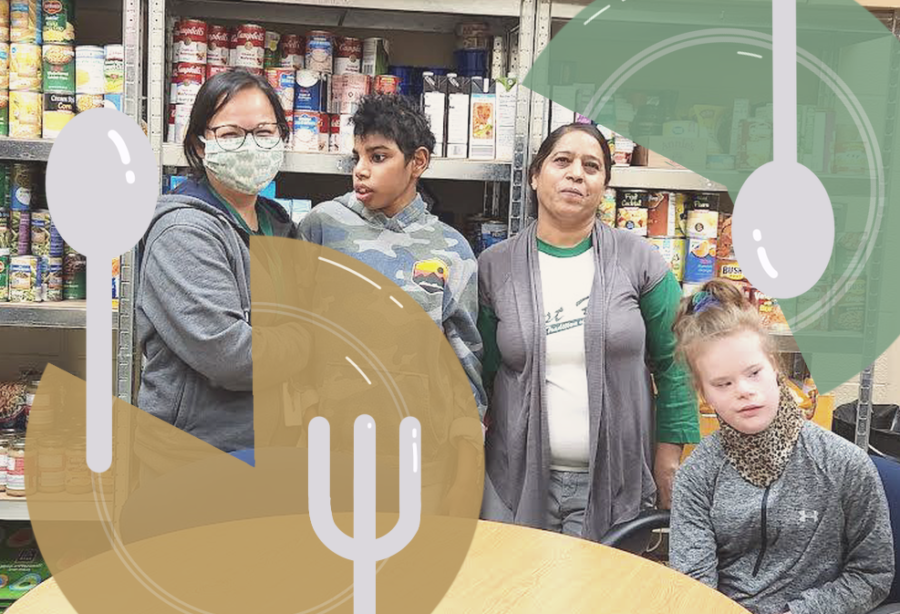Food inaccessibility is a widespread issue across the U.S., affecting more than 34 million people nationally. In Iowa alone, one in 14 people face hunger due to food insecurity, or lack regular access to nutritious food, as defined by the Food and Agriculture Organization of the United Nations.
Hunger among children is highly prevalent — in Iowa, one in nine children face food insecurity. The West High community is no exception to facing food insecurity.
Liberty High guidance counselor Mayra Hoskyn, a former West Spanish and Success Center teacher, started the West High Supply, West’s food pantry, in 2017 when she witnessed hunger’s impact on her students.
“I wish people knew that it’s very hard for [hungry] students to function and thrive in school,” Hoskyn said. “They tend to not be as connected, less involved, [have] more mental health issues and other health issues.”
In 2021, as a result of the COVID-19 pandemic, the ICCSD implemented a government-funded Free Meal Program that made lunch free for all students. The following year, when government funding was discontinued, the program was forced to stop, and school meals returned to their pre-pandemic cost.
Liz Kanagy-Imhoff, the West Kitchen Manager, views the end of free lunches for all as detrimental to students’ food security.
“I can imagine that there’s a good number of kids that this is the only meal they get a day,” Kanagy-Imhoff said. “Without a meal, your tummy’s rumbling, and you’re not going to do as well in school as if you had a full meal.”
Without a meal, your tummy’s rumbling, and you’re not going to do as well in school as if you had a full meal.
— Liz Kanagy-Imhoff, West Kitchen Manager
The Iowa Food Bank Association finds that the impact of hunger on education is profound. Food-insecure students have trouble with concentration, lower academic achievement and increased school absences, tardies and suspensions.
West paraeducator and West High Supply volunteer Omega Dancel affirms what staff members noticed among the student body before West High Supply was established.
“A lot of the students were hungry,” Dancel said. “The reason why some of the students were having a hard time concentrating was because they were hungry.”
Starting as a simple cabinet, West High Supply has since expanded and now occupies an entire room located between the current guidance offices and front doors.
The program operates throughout the year with help from volunteers as well as donations from community members, which include food, school supplies, hygiene products and graduation gowns.
Additionally, food drives hosted by West High Supply triannually provide aid to those in need of food. The most recent drive, which occurred before Thanksgiving Break, provided approximately 60 families with bags full of turkey, stuffing and green beans. For resource drives to prove successful, they require extensive planning and dedicated organizers.
“It’s nice to have food drives, but sometimes, it’s a lot of work to host one,” Dancel said. “In order to maintain one, [we have] to have good relationships [in the community] continue throughout the year.”
One of these relationships is with the Coralville Community Food Pantry, an essential provider of the food stocked at West High Supply. John Boller, the Executive Director of the Coralville Community Food Pantry, advocates for research and policy change to combat food insecurity.
“If someone isn’t getting enough food, it’s not their fault. It’s a systemic societal issue that they’re not responsible for fixing,” Boller said.
If someone isn’t getting enough food, it’s not their fault. It’s a systemic societal issue that they’re not responsible for fixing.
— John Boller, Executive Director of the Coralville Community Food Pantry
West paraeducator and West High Supply volunteer Samina Naz believes everyone, including West students, can support those experiencing food insecurity through destigmatization.
“There is a stigma; there’s a shame that if you need help, you’re kind of hesitant. So, my goal and wish is that we could move forward from that and make it no big deal,” Naz said.
Yet, West High Supply works hard to maintain discreteness when distributing resources so as not to draw unwanted attention to the students.
“We try to be mindful about not giving a plastic bag. Students are getting free food. We try to make sure that reusable bags are presented in a good way,” Dancel said.
Similar to West High Supply, Kanagy-Imhoff and the lunch staff try to be subtle when a student is unable to pay for lunch.
“I feel that we’re very safe,” Kanagy-Imhoff said. “We make sure we show discretion, so other kids don’t know they’re struggling.”
When addressing food insecurity, Hoskyn believes spreading awareness and understanding is critical.
“It’s about educating,” Hoskyn said. “We have a chance to educate parents and students that it’s not the student’s fault, it’s not the parent’s fault, it’s something that’s a system’s fault.”
Naz agrees that educating the West community on food insecurity is important and looks to first inform students of local resources.
“But now, [we need to] let our students know about [West High Supply],” Naz said. “[We] always have more knowledge for everybody that is accessible; [our resources are] for everyone, for students, staff and anybody.”
Often, providing food is an avenue for solving more complex problems in a community.
“The issue of hunger is not just related to food; it’s related to poverty and inequalities … That includes better wages or affordable housing, affordable health care, and of course, access to food,” Boller said.
Hoskyn holds that without policy changes, food insecurity will continue to diminish the health and education of people worldwide.
“Unfortunately, until we can resolve food insecurity, other issues can’t be triaged or helped,” Hoskyn said. “It’s something that has to change in a systematic way.”
This story was originally published on West Side Story on January 22, 2023.































![IN THE SPOTLIGHT: Junior Zalie Mann performs “I Love to Cry at Weddings,” an ensemble piece from the fall musical Sweet Charity, to prospective students during the Fine Arts Showcase on Wednesday, Nov. 8. The showcase is a compilation of performances and demonstrations from each fine arts strand offered at McCallum. This show is put on so that prospective students can see if they are interested in joining an academy or major.
Sweet Charity originally ran the weekends of Sept. 28 and Oct. 8, but made a comeback for the Fine Arts Showcase.
“[Being at the front in the spotlight] is my favorite part of the whole dance, so I was super happy to be on stage performing and smiling at the audience,” Mann said.
Mann performed in both the musical theatre performance and dance excerpt “Ethereal,” a contemporary piece choreographed by the new dance director Terrance Carson, in the showcase. With also being a dance ambassador, Mann got to talk about what MAC dance is, her experience and answer any questions the aspiring arts majors and their parents may have.
Caption by Maya Tackett.](https://bestofsno.com/wp-content/uploads/2024/02/53321803427_47cd17fe70_o-1-1200x800.jpg)
![SPREADING THE JOY: Sophomore Chim Becker poses with sophomores Cozbi Sims and Lou Davidson while manning a table at the Hispanic Heritage treat day during lunch of Sept 28. Becker is a part of the students of color alliance, who put together the activity to raise money for their club.
“It [the stand] was really fun because McCallum has a lot of latino kids,” Becker said. “And I think it was nice that I could share the stuff that I usually just have at home with people who have never tried it before.”
Becker recognizes the importance of celebrating Hispanic heritage at Mac.
“I think its important to celebrate,” Becker said. “Because our culture is awesome and super cool, and everybody should be able to learn about other cultures of the world.”
Caption by JoJo Barnard.](https://bestofsno.com/wp-content/uploads/2024/01/53221601352_4127a81c41_o-1200x675.jpg)






